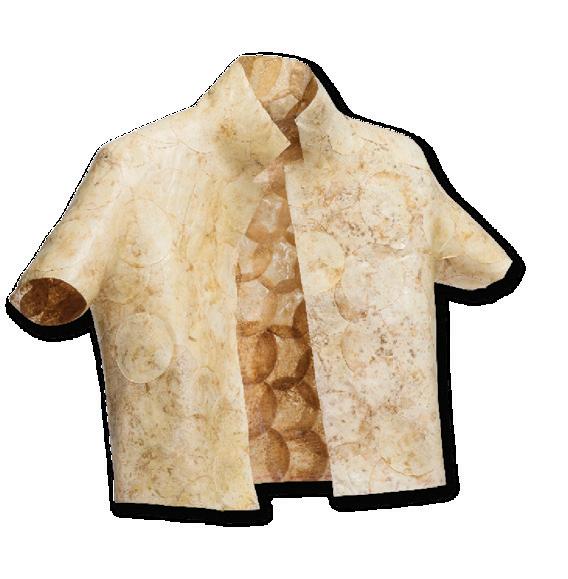
4 minute read
Playing an Active Part in Conserving Active Matter
by Mackensie Griffin (MA ’23)
This past March, I attended the opening of Conserving Active Matter, Bard Graduate Center’s exhibition exploring the activity of matter and a variety of human responses to it. Walking through the galleries, I passed by familiar acquaintances: there was the ibis mummy, the shattered silk dress, the marble Ganesh, and Vladimir Nabokov’s annotated copy of The Metamorphosis. Having taken the first of two “In Focus” courses related to the exhibition, seeing these items together and in-person for the first time was especially rewarding. I knew how much thought had gone into their presentation as this was the culmination of work the curators, designers, and my classmates and I had done over the past year.
Advertisement
I signed up for the “Conserving Active Matter” class in the latter half of my first year as an MA student (spring 2021), eager to take a course in which I’d be able to actively participate in mounting an exhibition for the BGC Gallery. Taught by the exhibition’s curators, Soon Kai Poh and Dean Peter N. Miller, the course began with expansive discussions of conservation that touched on everyday repairs, Indigenous ontologies, connoisseurship versus scientific analysis, and appreciation for the aesthetics of decay. Conversations around these topics had taken place throughout BGC’s ten-year-long initiative, Cultures of Conservation, and led to the development of questions around which the exhibition is organized: What is conservation? How is matter active? Who acts on matter, when, and why? Where is the future of conservation?
In February, each member of the class chose four objects from the exhibition checklist for which to write labels and catalogue essays.
Conserving Active Matter installation. Photo by Da Ping Luo.
From the items included in the “What is conservation?” gallery, I chose a piece of contemporary art that BGC had commissioned from Mark Dion for the lobby of 38 West 86th Street: The Conservator’s Cupboard. As a fan of Dion’s work, I looked forward to learning how this large cupboard crammed with instruments and materials spoke to the themes of our exhibition. From the “How is matter active?” section, I selected a faux tortoiseshell vanity set—an example of deteriorating early twentieth-century plastic—with the intention of examining its activity from a scientific and aesthetic point of view. From the “Who acts on matter?” gallery, I chose a marble figure of Ganesh from India, partly because I’d developed an affinity for the Hindu deity when I was a child and because I wanted to explore how the statue could be activated by worshipers or museum visitors. Lastly, for “Where is the future of conservation?,” I selected a biodegradable collar made by contemporary designer Aniela Hoitink for its connection to cultural and environmental conservation issues.
For the next several months, I researched these items, gaining valuable insights from makers, curators, and conservators. I chatted with Dion about how his early career as an art restorer informed the objects he included in The Conservator’s Cupboard and his willingness to accept a certain amount of activity in the piece; I consulted American Museum of Natural History curator Laurel Kendall and accession documents from the museum’s digital archives on the figure of Ganesh; and I interviewed Cooper Hewitt conservator Jessica Walthew about her work on early plastics. These conversations were fundamental to writing the labels and catalogue essays.
As I walked through the exhibition, I noted transparent room dividers, objects suspended from the ceiling, the different colors of each room (deep blue, white, grey, light green), and I recalled the inspiring conversations my classmates and I had with David Harvey, the exhibition’s designer, who encouraged us to think about the physical space of the gallery, how to guide the visitor’s perception and path, and how to tell a story through visual design. To evoke the feel of an exhibition, Harvey creates mood boards. He asked the
class to do the same for Conserving Active Matter and visualize each of the exhibition’s themes. This highly enjoyable assignment engaged our creative brains, and, gratifyingly, these digital collages now flashed across screens installed in each of the galleries. Wanting to stay connected to the project after the class ended, I applied for a digital fellowship through which I could help construct the show’s companion website. In doing so, I got a behindthe-scenes look at how director of digital humanities and digital exhibitions Jesse Merandy and art director Laura Grey designed the site to visually align with the physical exhibition and added supplemental features including a clickable checklist that sorts items by their material and place of origin, essays written by conservation scholars and BGC faculty, and audio clips of students’ interviews with conservators. The digital exhibition in itself can be seen as a form of conservation in that it will preserve the show online, making it accessible to the public long after it has closed.
Through participating in various aspects of the show, I gained a better understanding and appreciation of its many moving parts. I’m thankful to have had the opportunity to receive such a multi-faceted introduction to the exhibition-making process; it has certainly activated my interest in this kind of work.
Aniela Hoitink, designed in collaboration with Karin Vlug. MycoTEX seamless jacket, 2018. Mushroom mycelium. Courtesy of Aniela Hoitink | NEFFA. Photo by Jeroen Dietz.











